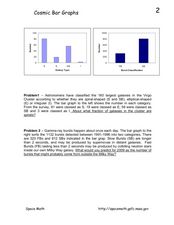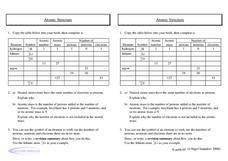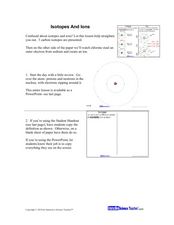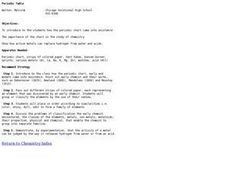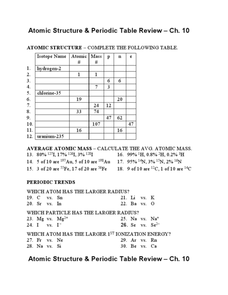Curated OER
Scientific Notation III
In this scientific notation worksheet, students solve 10 problems where they multiply and divide numbers using scientific notation and they express their answers with the proper number of significant figures.
Curated OER
Cosmic Bar Graphs
In this cosmic bar graph worksheet, students solve 2 problems using given bar graphs that plot the number of galaxies vs. the galaxy type and the number of gamma-ray bursts vs. the burst classification. Students find the fraction of...
Curated OER
Absolute Ages of Rocks
In this age of rocks worksheet, students answer five matching questions about terms related to the decay of atoms. They use a strip of paper to simulate half life of atoms and determine the total amount of time it took to deplete the paper.
Curated OER
Ionic Bonds
In this ionic bond learning exercise, students read about the transfer of electrons from one atom to another in ionic bonds. They answer seven questions about sodium and chlorine and draw Bohr-Rutherford diagrams to show the bonding...
Curated OER
States of Matter
In this states of matter worksheet, students are given 15 statements and they fill in the blank with terms related to solids, liquids and gases and the transition from one state to another. Students use the clues to complete a crossword...
Curated OER
Radiochemistry
For this radiochemistry worksheet, students read about how scientists learn more about elements using radioactive isotopes. Students answer three critical thinking questions about the reading and radiochemistry.
Curated OER
The Many Faces of Energy
In this energy instructional activity, students are given a table of the many measurements of energy. They solve 6 problems converting from one measurement of energy to another using the conversion factors given.
Curated OER
The Hand of Chandra!
For this nebula worksheet, high schoolers read about the Chandra X-ray Observatory that captured the given image of a pulsar and its nebula. Students solve 3 problems including using similar triangles and proportions to find the image...
Curated OER
How Fast Does the Sun Spin?
In this rotation of celestial bodies worksheet, students determine the speed of the sun's rotation and they determine the number of days it takes the sun to rotate once at the equator. They identify the geometric factor that causes...
Mr. E. Science
The Periodic Table
This science presentation focuses on the elements in the periodic table. It begins with the parts of an atom, explaining atomic mass and atomic number, valence electrons, and isotopes. Then it moves on to discuss various ways of...
Texas State Energy Conservation Office
Investigation: Splitting Atoms
In a simple activity, physical scientists model nuclear fission using a droplet of oil. This can be used alone in a unit on different types of energy, or as part of the energy conservation unit produced by the Texas State Energy...
Glynn County School System
Lives and Deaths of Stars
Star light, star bright ... just how long can you wish on that star? Well, it depends on its mass. The presentation explains the life cycle of stars based on their sizes. Scholars learn about the life expectancy of a star based on the...
Flipping Physics
AP Physics 1: Electrostatics Review
AP Physics scholars will be excited to find this review of electrostatics as they prepare for the AP exam. Fast-paced, interesting, and comprehensive, the video also includes test-taking tips and common misconceptions.
University of Georgia
Bag O' Isotopes
Accommodate your chemistry class with an experiment that is both entertaining and educational. Through the activity, blossoming chemists perform calculations on various isotopes, as represented by beans and legumes, to obtain...
Biology Junction
Chemistry
You matter—unless you multiply yourself by the speed of light squared, then you energy! Scholars learn about matter, energy, the elements and so much more using an informative presentation. Completing the included worksheet creates a...
PHET
Learning about Space Weather
Is the sun the only celestial body with magnetic fields? A guided discussion on the weather in space is designed with a mix of questions, discussions, explanations, and applications. Additionally, the resouce includes an...
Curated OER
Isotopes; Molecular Notation; Electron Orbits
In this isotopes, molecular notation, and electron orbits activity, high schoolers read selections pertaining to isotopes, mass number, molecular notation, electric attraction, and electron orbits. In addition, students complete 11...
Curated OER
Atomic Structure
For this elements worksheet, students complete a graphic organizer by filling in the element symbol, atomic number, atomic mass, and the number of protons, electrons, and neutrons. Then students complete 2 short answer questions.
Curated OER
Isotopes and Ions
Students examine the concepts of isotopes and atoms. In this powerpoint lesson, students see the balance in numbers of protons, neutrons, and electrons create isotopes and ions of certain atoms.
Curated OER
Charge Challenge
Students observe the behavior of different charged objects. In this science lesson, students perform a series of static electricity experiments. They discuss their observations in class.
Curated OER
Periodic Table
Students identify the periodic table trends and predict material properties. They also design and conduct simple experiments and test material properties. Finally, students compare and contrast material properties and that chemical...
Curated OER
Atomic Structure and Periodic Table Review
In this atomic structure and periodic table worksheet, students complete a table with isotopes, their atomic masses, the number of protons, neutrons and electrons and mass number. They also find the average atomic mass of atoms and...
Curated OER
The Atoms Family-Atomic Math Challenge
In this atoms worksheet, students determine the number of protons, neutrons, electrons, the atomic mass and the atomic number of 16 elements.
Curated OER
How do protons stick together in a nucleus?
Students explain that the Standard Model of the atom includes particles beyond protons, neutrons, and electrons. They describe the nucleus as conglomeration of quarks that manifest themselves as protons and neutrons.

